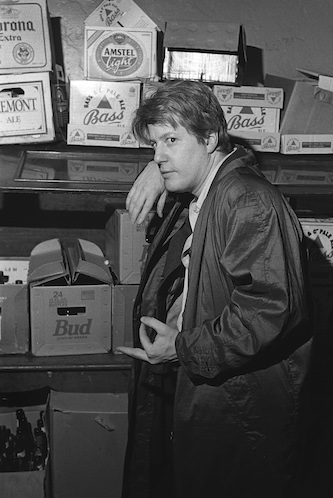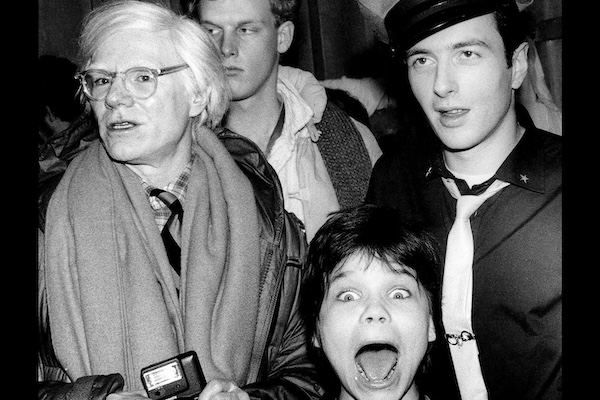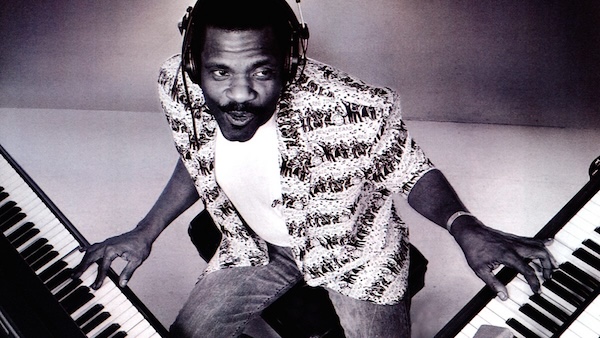Arts Feature: The 10 Best Music Documentaries of 2024 — Along with Others Worth Watching and a Few Disappointments
By Noah Schaffer
If there’s a documentary on this list that you want to see and it isn’t readily available, I’d suggest following it on social media or checking if its website has an email list that will announce future screenings or streamings.

A scene from The Fuzztones vs The World.
Music documentaries continued to be released at a brisk pace in 2024, though the ways to view them continued to shrink. Major streaming outfits such Netflix and Amazon Prime have essentially abandoned the genre — unless a film is about a major star. Those searching for deeper slices of music history are left to scour local film-house listings or to hope a filmmaker can come up with the often hefty licensing fees required before a movie can be rented as a Video on Demand (VOD) option.
One of the most welcoming theater venues here in Boston is the Regent in Arlington, which has already scheduled a February 6 premiere screening of The Fuzztones vs The World, a promising look at the long-running saga of a New York garage band. Screenings of several films here locally were the result of the tireless efforts of nonprofits, such as the Independent Film Festival Boston and Wicked Queer. Another great Boston fest, RoxFilm, screened the Luther Vandross doc Never Too Much. I couldn’t make it, so I’ll have to wait until it runs on CNN on New Year’s Day.
Because these mostly independent features can take years to move from the festival circuit to the small screen, my criterion for whether they were actually a 2024 film is simply based on when I got to see them. That means some flicks on the list received considerable acclaim when they garnered limited releases last year, while others have just started to be screened. (As in past years, I found the DOC NYC festival’s streaming site to be an especially helpful way of catching up with the freshest batch of docs.) My Arts Fuse colleague Steve Provizer’s review of Soundtrack to a Coup d’Etat makes me suspect that it will be on this list next year, once it hits the library streaming service Kanopy in 2025. If there’s a doc on this list that you want to see and it isn’t readily available, I’d suggest following it on social media or checking if its website has an email list that will announce future screenings or streamings.

A scene from Googoosh: Made of Fire.
Googoosh: Made of Fire – Many music documentaries are dedicated to the power of song as a tool of protest and activism. This effort is also brutally honest about the limitations of this linkage. Googoosh came to fame both in her homeland of Iran and abroad as the queen of Persian pop. Her swinging ’60s and ’70s performances glamorously mixed Iranian musical poetry with rock and soul influences. When the Shah was replaced by the Ayatollah, secular singers, writers, and actors found themselves banned, or worse.
Googoosh was already the subject of an earlier documentary about how the memory of her music persisted even after she was silenced. After living anonymously in Iran for decades, the singer has in recent years resumed her career in exile, playing to massive crowds in the Iranian diaspora. This film captures how her lengthy farewell tour was occurring at the same time as the activist uproar inspired by the 2022 police murder of Mahsa Amini. Googoosh speaks out and records a protest anthem, but she also confides to viewers that she feels helpless as she watches from afar. The film is currently on the festival circuit.
Joan Baez: I Am a Noise – Although it played theaters in 2023, this unflinching look at the ’60s folk queen made it to streaming this year on Hulu. Baez is best known for her beautiful voice and courageous political stands. But the film presents Baez at her most vulnerable: grappling with the repercussions of her childhood even as she’s playing to adoring audiences on her farewell singing tour.
Any Other Way: The Jackie Shane Story – While she was hardly a superstar, transgender ’60s soul singer Jackie Shane made nightclub appearances that were so thrilling that audience members (including those who saw Shane at Louie’s Lounge in Boston’s South End) talk about her to this day. In the ’70s Shane disappeared from public view, only to be located, near the end of her life, living in seclusion in Nashville.
Audio interviews Shane did for the liner notes of the Grammy-nominated reissue of her work form much of the film, along with animated recreations that, in this case, are done far more tastefully and effectively than they usually are. Unsurprisingly, a few details about Shane’s life are never quite filled in, but the film successfully keeps the viewer engrossed in the life story of someone they’ve likely never (or barely) heard of. Given that the world’s richest man, Elon Musk, has put politics ahead of family by cutting off communication with his transgender daughter, it is especially moving to learn about the unyielding love Shane’s mother figure (her biological aunt) gave to a queer child in the Jim Crow South of the ’50s. The film is currently on the festival circuit.

Billy Ruane pointing at a box of Budweiser. Photo: Eric Antoniou
The Road to Ruane – The word “scenester” doesn’t do justice to Billy Ruane, who was perhaps the biggest fan and friend that the Boston music community ever enjoyed. His generosity (and family’s wealth) allowed him to promote and pay indie rock and avant-garde jazz artists whose commercial appeal was nil. Few audience members will forget his spasmic dance moves and drunken band introductions. Ruane, who battled bipolar disease, lived a life of ecstatic highs and crushing lows. There’s no shortage of great Billy stories from his pals, and they’re also blunt about the challenges that were part of being in the Ruane orbit. Filmmaker Scott Evans, who took up the mantle when the film’s original director, Michael Gill, passed away, does an excellent job of showing why, as exasperating as he could be, Billy Ruane was a one-of-a kind figure well worth celebrating. The film is currently on the festival circuit.
Swamp Dogg Gets His Pool Painted – R&B singer/songwriter Jerry Williams, better known as Swamp Dogg, has never made anything approaching ordinary music. So it’s fitting that this film is anything but a conventional documentary. That said, it coherently details Williams’s distinctive career, even as its subject tells us about his currently crazed life: cohabitating in a Los Angeles house with blues journeyman Guitar Shorty (who has since passed away) and longtime musical collaborator Moogstar. Just like its subject, this film is very funny and deeply insightful at the same time. The film is currently on the festival circuit.
Getting It Back: The Story of Cymande – The best films about underrated musicians supply some kind of redemption at the end, and this is the case with Cymande. The Black Afro-Caribbean outfit formed in London and immediately distinguished itself by playing a particularly distinctive blend of funky jazz. As the group’s founders explained in a recent Arts Fuse interview, they were able to score a US record deal and a tour with Al Green, but they never got their due at home. After the band split, their beats became irresistible sample material for hip-hop DJs and producers. The group has reunited (and has a new album and US tour coming soon). The film is playing theaters in the US and is available for streaming in the UK.
Yacht Rock: A DOCKumentary – Bill Simmons’s HBO doc series Music Box can be hit or miss, but this look at how soft rock titans like Christopher Cross, Toto, and Michael McDonald have been retroactively labeled ‘”yacht rock” artists is a real gem. There’s inevitably lots of humor — the term was coined by a web comedy series, and a Cross/McDonald collaboration yielded one of SCTV’s funniest sketches. But there’s also a deep appreciation for the stellar studio musicianship and songwriting craft that made the best of “yacht rock” so enduring. The film is currently streaming on MAX.

A scene from Harley Flanagan: Wired for Chaos. Photo: Marcia Resnick
Harley Flanagan: Wired for Chaos – There have already been some good films, such as American Hardcore, that go into the history of hardcore music and the underground DIY communities the movement has spawned. This effort is a character portrait of Harley Flanagan, the longtime lead singer of the Cro-Mags, and he proves to be a most fascinating figure. This is someone who grappled with neglect and turbulence in his childhood, and who has struggled — sometimes successfully, sometimes not — to find inner peace in his own life, even while making abrasive music. You certainly don’t have to be a hardcore music fan to appreciate this powerful film. The film recently made its festival premiere.
Fanatical: The Catfishing of Tegan and Sara – While hardly household names, the twin sister duo of Tegan and Sara have garnered a significant following for their queer indie rock for the better part of 25 years. And for much of that time the group and their fans have had to contend with a mysterious scammer who has impersonated Tegan in online chats with the group’s fans. It’s a spooky, disturbing look at the price musicians pay for being in the public spotlight.
Disco: Soundtrack of a Revolution and Disco’s Revenge
Last year this list contained two films about Little Richard that rounded up some of the same talking heads. There’s even more overlap between these two films, one a three-part PBS/BBC series and the other a Canadian feature. They both do a fine job detailing disco’s origins in Black and queer underground spots as well as its eventual downfall before reemerging as house music. Such crucial early disco figures as singer Nona Hendryx, drummer Earl Young, and DJ Nicky Siano are interviewed (extensively) in both films. The longer PBS series is inevitably more in-depth, letting viewers learn more about Young’s musical innovations, the role of Black female divas, and post-disco dance music. But, thanks to the useless presence of rock radio consultant Lee Abrams, it supplies a weaker take on the Chicago disco record burning riot (which was itself the subject of its own PBS film that was on this list last year). Disco’s Revenge benefits from the participation of co-executive producer Nile Rodgers and his Chic bandmate Norma Jean Wright. Disco: Soundtrack of a Revolution is streaming on PBS’s Passport service. Disco’s Revenge is on the festival circuit.
“Worth watching” Honorable Mentions:

A scene from Billy Preston: That’s the Way God Planned It
Billy Preston: That’s the Way God Planned It – Speaking of notable ’60s and ’70s session keyboardists, this portrait of the “fifth Beatle” is an excellent look into the rise and sad decline of a true musical genius. Along with Preston’s invaluable contributions to the Fab Four and their solo efforts, his gospel roots and mid-’70s heyday are chronicled with a deep dive into archival footage. It’s far from a cheery story, as Preston battles substance addiction, changing musical taste, and a life as a closeted gay man. Thankfully the film has survived a now-settled lawsuit from Preston’s manager Joyce Moore and her husband Sam Moore, because it deserves to be seen.
Born to Be Wild: The Story of Steppenwolf – Not quite one-hit wonders, but also not enduring superstars, ’60s rockers Steppenwolf are the kind of band that can be challenging to contextualize. This beautifully filmed effort does a pretty good job at both relating the band’s history while serving up modern-day portraits of two interesting characters: lead singer John Kay and bassist Nick St. Nicholas. Ironically, it took the film’s premiere to get those two long-estranged members speaking again. The film is on the festival circuit.
Beautiful Was the Fight – This sweeping look at women in the Boston music scene is an ode to inclusivity and community. There are plenty of indie riot grrrls, but also artists creating everything from hip-hop (Red Shaydez) to jazz (Yoko Miwa). The subjects are brutally honest about the challenges posed when it comes to performing music in an expensive city with early hours. But they are also grateful for interactions with cohorts and fans that keep them inspired. There’s sadness here: since the film was shot some of the venues have closed and a selection of the artists (such as Ruby Rose Fox, whose song inspired the film’s title) have moved to other cities. But it is hard not to admire the determination that keeps these artists going. The film has been playing at area festivals and theaters.
The Session Man – Nicky Hopkins was the go-to pianist for everyone from the Who and the Kinks, to the Stones and countless other classic rock stars. The film starts off strong as Tom Jones sideman Paddy Milner sits at a keyboard and demonstrates exactly what made Hopkins stand out. But, as with so many music docs, padding comes along to ensure the film reaches feature length. A third of the 90 minutes could have easily been snipped by excising interviews with some of Hopkins’s less memorable studio clients, including a replacement member of Badfinger and one of the Stray Cats, who hired Hopkins for a solo project.

A scene from Breaking Silence: Janis Ian.
Breaking Silence: Janis Ian – Folk singer Janis Ian was only 14 when she wrote “Society’s Child,” the song about interracial relationships that first brought her to national attention. In the years since that 1965 release her fame and personal fortunes have waxed and waned, but Ian never wavered in her commitment to the craft of songwriting. As a subject, she is funny and reflective, with a knack for telling a great story. Alas, it is a shame that this otherwise impeccable film relies on some particularly trite and obvious reenactments of key moments in Ian’s story. The film is on the festival circuit and it will eventually be broadcast on PBS’s American Masters.
Resynator – Even ardent synthesizer history buffs may not have heard of Don Tavel, a talented guitarist and songwriter who invented the resynator, an instrument-controlled, pitch-tracking synth, in the late ’70s. Tavel’s daughter Alison was an infant when he died. Now she’s trying to figure out both his complicated life and how to get the resynator she found in her aunt’s attic up and running. Some famous musicians check the device out, but one of the doc’s most joyful scenes turns out to be when a group of Colombian analog synth enthusiasts embrace the instrument’s possibilities. This film may be about the fate of a machine, but it is a heartwarming, nicely made tale about humanity. The film can now be rented or bought on Apple TV.
Stax: Soulsville USA – Prior to this year’s HBO series the fabled Memphis soul music label had been the subject of at least four prior documentaries (most of which can now be seen on YouTube). And that is not even counting films and programs dedicated to Stax artists like Isaac Hayes, Otis Redding, and Mavis Staples of the Staples Singers, general Memphis soul docs, or concert films, including the label’s own WattStax documentary.
Still, given the importance of Stax’s output and its complicated and messy business history, the four hours go by quickly, and there isn’t even time for in-depth looks at the likes of the Staples, William Bell, or Eddie Floyd. Happily, co-founder Jim Stewart was filmed before his 2022 passing. Also, one benefit of attrition is that important but lesser-known voices, like songwriters Deanie Parker and Bettye Crutcher, are given lots of screen time. The fourth episode, detailing the label’s demise, is told through the self-serving lens of Stax’s final honcho, Al Bell. Thus the hard work done by Memphis locals to make the Stax rubble a world-renowned museum and academy is only acknowledged via a caption as the credits start to roll. Bottom line: consider the series a joyful way to spend four hours, but it is no replacement for the thorough history found in the Stax books penned by Robert Gordon and Rob Bowman. The film is currently streaming on MAX.
When Houston Had the Blues – This lovingly crafted look at Houston’s outsized role in blues, R&B, and zydeco history features not just big names like Big Mama Thornton and Lightnin’ Hopkins, but lesser-known greats like guitarist Milton Hopkins and Grady Gaines, the saxophonist and bandleader who was a crucial contributor to Little Richard’s sound. Both musicians have since passed away, so filmmaker Alan Swyer has done blues fans a great service by capturing their stories for posterity. The film is currently available via several Video on Demand services, including the free Tubi service.

Singer Gloria Gaynor. Photo: courtesy of the artist
Gloria Gaynor: I Will Survive – The song “I Will Survive” has become such a global anthem it has somewhat overshadowed the woman who sang it, Gloria Gaynor. This engaging doc follows Gaynor as she tries to resuscitate a career that her ex-husband had mismanaged. It’s also an insightful look at how she went from being a nightclub singer to a disco diva.
The doc also examines what it is like to be an older female artist with a record everyone knows. On the one hand, Gaynor is a star attraction when she’s being led to a charity gala stage through a kitchen of amazed caterers or when she visits a Spanish school whose children made a viral “I Will Survive” video. Yet her new manager’s attempts at shopping Gaynor’s excellent self-financed rootsy gospel album is met with disinterest by record labels. Yes, it is the industry’s ageism, but also the challenges of trying to move into a new genre. Any fan of spiritual music, whether it’s made for the church or the dance floor, will come away with a new appreciation of Gaynor’s determination: she makes her art on her own terms. The film has been on the festival and theater circuit, and potential viewers can join its email list.
Brenda Lee Rockin’ Around – Even by the usual standards of PBS’s American Masters this concise, 50-minute doc is an ultraconventional offering. Brenda Lee, whose recordings as a teen smashed boundaries for women in rock, is particularly worthy of this kind of celebration — especially now, since she’s back at the top of the charts with “Rockin’ Around the Christmas Tree.” The ceaseless conga line of talking heads includes not just friends and serious music historians but also, in what one hopes will not become a music doc trend, a pair of song reaction YouTubers. All the talking means that viewers hear only short snippets of Lee’s powerful voice. Still, nice insights are supplied into both how her music developed and how she’s managed to live her life on her own terms. The film is currently streaming on PBS’s website.
Harder Than the Rock – Long before the likes of Steel Pulse brought British reggae universal acclaim, the band Cimarons pioneered the roots reggae sound in the UK. Reggae history addicts will appreciate this exhaustive look at a history that included collaborations with Bob Marley and Paul McCartney — and still continues to this day. The film is playing theatrically in the UK.
Not Not Jazz – This is the second film about the group Medeski Martin & Wood. This time the trio are captured during a 2017 recording session. The film succeeds at enlivening the awkward and often boring process of studio recording with delightful visuals, and that is no small feat. Things get a bit trickier with the narrative, since any MMW fan will be aware that the band rarely performs live anymore. In fact, the sessions filmed here have yet to yield an actual album. The band celebrates the impact they made in the ’90s by merging conservatory training with a punk road warriors ethos. They also admit that, eventually, their collaboration burned out — these days bassist Chris Wood mostly makes music with his brother Oliver as the Wood Brothers. So why focus on this band and, especially, why now? Those questions are never really answered. The film is available for rent or purchase on numerous video on demand services including Apple and YouTube.
Biggest disappointments:

A scene from Hargrove.
Hargrove – Trumpeter Roy Hargrove upended the jazz world when he came on the scene as a remarkable player in the ’90s, and then again when his RH Factor mixed jazz and hip-hop with unusually successful results. He could also be self-destructive, and his death in 2018 at the age of 49 was met with an outpouring of grief from the music world. In the months before he passed away filmmaker Eliane Henri filmed Hargrove as he toured Europe — but not his live performances because of a rights disagreement between Henri and Hargrove’s controversial manager, Larry “Ragman” Clothier. The film suffers once Henri’s conflicts with Clothier overwhelm both her objectivity and the movie’s focus. (A closing caption blames Clothier for blocking the use of Hargrove compositions in the film’s soundtrack.) The film leans heavily into the now antique trope of a white manager exploiting a major Black talent. What Henri conveniently fails to tell viewers is that Hargrove’s wife and child have also denounced the film as have others who witnessed the complicated relationship that Hargrove and Clothier had. That said, this is still worth seeing because of the insights provided by Hargrove’s peers, especially his younger band mates, into the trumpeter’s musical genius and the demons that ultimately conquered him. The film is now streaming on YouTube.
BOOM! A Film About The Sonics – This mid-’60s proto-punk Tacoma teenage combo didn’t last long, but they created some of the most ferocious and beloved garage rock and R&B of all time. Most of the members quit music and went on with their lives until, after years of fan requests, they reunited in 2007, sparking a series of successful world tours and recordings. And, when the film was being shot, all of the band’s members, plus their original manager, were still around and happy to tell their story.
The problem is that the film devotes just 30 minutes to the band’s glory days, and the director insists on inserting a treacly tale of how the Sonics helped him and his dad bond. Even worse, there’s a soundtrack of generic background music that is anything but rockin’. This comes across as a doc made during the streaming heyday, with the intention of reaching a large audience who had never heard of The Sonics and who would find their story endearing. But, in the current distribution era, Boom! is likely to be seen largely by those who already love the band; they will not need to be told by members of more tepid Northwest groups — like Heart and the Presidents of the United States of America — why the group was important. Sonics lovers will probably come away thrilled that their underappreciated heroes made it to the big screen, but will wish more had been explained about how the band came up with such explosive songs as “Boss Hoss” and “Strychnine.”
Noah Schaffer is a Boston-based journalist and the co-author of gospel singer Spencer Taylor Jr.’s autobiography A General Becomes a Legend. He also is a correspondent for the Boston Globe, and spent two decades as a reporter and editor at Massachusetts Lawyers Weekly and Worcester Magazine. He has produced a trio of documentaries for public radio’s Afropop Worldwide, and was the researcher and liner notes writer for Take Us Home – Boston Roots Reggae from 1979 to 1988. He is a two-time Boston Music Award nominee in the music journalism category. In 2022 he co-produced and wrote the liner notes for The Skippy White Story: Boston Soul 1961-1967, which was named one of the top boxed sets of the year by The New York Times.
Tagged: "Any Other Way: The Jackie Shane Story", "BOOM! A Film About The Sonics", "Beautiful Was the Fight", "Billy Preston: That’s The Way God Planned It", "Breaking Silence: Janis Ian", "Brenda Lee Rockin’ Around", "Disco: Soundtrack of a Revolution", "Disco’s Revenge", "Fanatical: The Catfishing of Tegan and Sara", "Getting It Back, "Googoosh: Made of Fire", "Harder Than the Rock", "Hargrove", "Harley Flanagan: Wired for Chaos", "Not Not Jazz", "Resynator", "Stax: Soulsville USA", "Swamp Dogg Gets His Pool Painted", "The Road to Ruane", "The Session Man", "When Houston Had the Blues", "Yacht Rock: A DOCKumentary", Bor"n To Be Wild: The Story of Steppenwolf", Gloria Gaynor: I Will Survive

I hope to see some on this intriguing list – thanks for the tips.
Always well researched, concise and informative it’s so nice to know true journalists still exist. It is our job to make sure they survive!
Kudos to you, my friend. Honor to know you!
Time for a documentary about you, Mimi!
Yes thank you for this.
BTW, I just saw a rock doc on the early ‘70’s all-female queer Filipino rock band Fanny which Bowie advocated at the time called ”Fanny: The Right to Rock” (2021) on Kanopy…check it out!